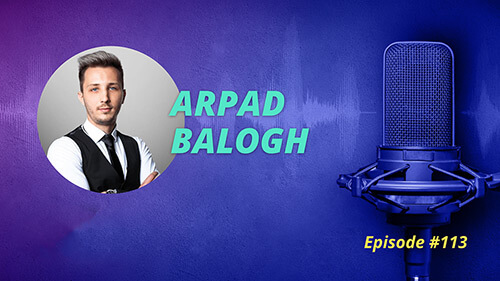 Marketing Intelligence
Marketing Intelligence
In Search Podcast: 5 Steps to Generating Successful AI Generated Content

Is it really possible to create all of your content on an automated basis using AI?
That’s what we’re going to be discussing today with a man who has a blue belt in Brazilian jiu-jitsu and is an amateur singer who wants to be famous. He has a website where he creates weird stories using AI. And he helps small businesses learn SEO and he’s also a Senior SEO strategist at Ardour SEO. A warm welcome to the In Search SEO podcast, Arpad Balogh.
Arpad will be sharing five steps to creating successful AI-generated content.
The steps are:
- Research, research, research
- Make an outline
- Use an AI writer to generate content
- Make a standard operating procedure (SOP)
- Optimize AI content with Surfer SEO
Creating Successful Ai-Generated Content
Arpad: Thank you very much, David, for having me. It’s going to be a pleasure to be talking about AI today.
What I’m going to be talking about today is the state of AI, the AI generation, and how you can use these tools. Because what I’ve seen most of the time, in SEO communities, and a lot of forums is that people are not truly aware of how to generate good content with AI. And I think AI today is definitely not at the state where you can just press a button and generate perfect content, it still needs that human interaction. But if you do things right, you can get spectacular content out of your AI.
First of all, I just would like to mention a little bit about the back end of AI and how it works. I’m definitely not a coder so I don’t know the exact insides of how AI is built and how they are coded but I use a lot of AI tools, I tested a lot of them, and I generally know how they work and how to use them. So most of the AI tools I have tried out are built using the GPT-3, which is a machine learning model trained using internet data to generate any type of text. And it was developed by Open AI, which was founded by a lot of people. But what I liked the most is Elon Musk. I mean, he kind of has his hands in everything. And he thinks AI is dangerous, but I really think AI can be helpful. It makes people’s lives easier. And it takes away the most time-consuming tasks.
D: Yeah, a few years ago, Elon certainly was very negative about AI. But nowadays, he’s jumped on the bandwagon thinking if you can’t beat them, join them, and I’m going to lead them.
A: Exactly. And Tesla uses machine learning as well to detect roads, how they are built, and what kind of roads people are driving on. And it builds up this huge database of roads. And that’s how the Tesla can self-drive because it has this database. It has a lot of use cases. Right now we are talking about content but I can imagine a lot of dangerous work could be replaced by machines driven by AI.
Another really interesting thing is that GPT-3 is trained on 40-45 terabytes of data. That includes common crawl, which is about 400 billion pages on the internet. It is trained on books, it is trained on Wikipedia. It just has a huge amount of data. Just like we talked about use cases, it’s not only used for content generation, there’s been a lot of talk on Twitter and other social networks that people use it for code writing. It can help you write software, which to me is pretty mind-blowing. So there’s been a surge recently in these types of software. I can see a lot of them in Google Ads, Facebook, a lot of SEO communities, and a lot of AppSumo deals. It seems like everyone and their mother is making AI now.
D: You’re like interviewing Duane Forrester. You can ask him one question and then you can just leave for 10 minutes and you can come back and he’ll still be sharing great information. It’s a compliment, though. You were talking about different tools out there. And it’s great to have that background of AI, but what would you say are some of the best AI tools out there that can be used to create content?
A: I have tested a lot and the most recent I tested was ClosersCopy AI but there’s been a surge of these AI tools recently. You can find a lot of these tools. And to be honest with you, I’m an affiliate with Jasper and you mentioned before the show that you used Jasper, Jarvis, or Conversion AI before. It’s quite interesting because their name was Jarvis and Disney approached them saying that you shouldn’t use Jarvis in your name because we will sue you. And that’s why they changed it to Jasper. I might mess up and mix up Jarvis and Jasper throughout the show. But I really think Jasper is the only tool right now yet on the market that produces content that’s actually usable. Jasper has a function that most AI tools don’t, which is called boss mode, which lets you give specific comments or instructions to the AI itself. A lot of these tools, work by giving you templates, they give you certain boxes that you can fill in to generate questions and answers. But with Jasper, you’re actually able to give specific instructions, like write me metadata using the text above or something like that. Something that’s not actually in a template, but you can think of it yourself.
D: So when I tried Jarvis or Jasper now, I think the only reason that I felt that it wasn’t particularly useful for me is that there was quite a short limit I felt on the amount of content that could be produced. Is that still the case? What’s the largest length of content that can be produced from that tool?
A: They recently changed a pricing structure. I have a personal account, and we have an accountant account at my company, we are grandfathering into the unlimited plan of Jasper. If you’re joining now, I agree it’s a little bit pricey. And you have different options, like how much you can actually generate. I believe the lowest option is 30,000 words or something like that, which you can pretty much outdo if you’re just starting out. What I’m going to share with you today is how you can limit this and actually get out good content. But if you have the unlimited plan, it’s really unlimited. Now the lowest plan is 30,000 and it’s upwards, then how much you want to pay. And boss mode, of course, is a little bit pricier as well. But again, Jasper is a little bit pricier than the competitors, but at the same time because they are more pricey they’re able to have a full team behind the curtains to train the AI, give you templates, give you functionalities, and they really are working on making it better and better. And when GPT-4 will come out, which I don’t know when it will, it’s going to have a lot more data, it’s going to be much more interesting. And I’m really excited to see how advanced it will be.
D: So today, you’re going to be sharing your five steps to creating spectacular content with AI. Starting off with number one, research, research, research.
1. Research, Research, Research
A: Exactly. A lot of people mess up with these AI tools is they think it’s a magic pill. It’s in human nature to want a magic pill, you press one button, and all your problems will go away. What I see in the SEO and AI communities is that when people are not happy, generally what they do is spend five minutes in the software, maybe enter the keyword, press generate, and they didn’t like the content, so they refund it. We must understand that AI is not a content-generating machine yet. It’s kind of like an AI writing assistant. There’s still that human factor that must be used in order for good content to come out of these tools. And while Jupiter Tree has 45 terabytes of data, it doesn’t necessarily mean it knows every single topic you want to write about.
D: So by research, what elements do you need to put into the machine in order to actually produce results that a reader would be happy with?
A: That’s a good question. Because I said that what people get wrong is not putting enough data into these AI writing tools. A lot of these tools, like Jasper, have this content editor where you can input data, other tools, like Closers Copy, for example, as far as I could test, it just works on templates. You cannot really prime it with data. But the most important thing is to put data into the content editor of the software.
What kind of information can you put? Pretty much anything and it’s interesting. I’ll spill the beans on how we basically use this tool to write copy. It can write informative articles and at the same time, you can use it to write copy and give you ideas. What we do is for every client that we get, we do a story brand framework for them. A story brand framework is based on the book by Donald Miller, “Building a Story Brand,” and it’s an awesome marketing book. If you have the chance, read it. And it’s based on the basic principles of a story.
2. Make an Outline
If you have ever watched a movie or read a fantasy book, you already know this, but it helps. You build a framework or build marketing material that helps you communicate better with your audience and give clear marketing texts. How it builds up is that every story build starts with a character, then that character encounters a problem, then that character meets a guide, then that guide gives the character a plan, how to solve that problem, and then calls them to action. And then the story can end in success or the guide can help you avoid failure. Why am I telling this? Because by completing this kind of story brand framework with all of our customers, we get a bunch of information about the client. The motivations, the customer avatar, and every bit of real information we need for the copy.
Back to AI, how are we using this in AI? We get the story brand framework, and we just simply copy-paste it into the AI tool. And it’s interesting how clever it is. Once you add that content, it goes back, reads the content, understands it, and if you give it a comment, like write me a catchy headline for the front page of my website, it will, as I said, go back, read the content, understand who your customer is, according to the data and write your content by how it relates to that. You have to try it a few times but it’s good content. Versus if you don’t add any information, it will be pretty much generic, because it uses data from its current database.
D: That was step number two, make an outline. Step number three is using these tools to generate content.
3. Use an AI Writer to Generate Content
A: I just want to step back to step two a little bit to make an outline because you still must make an outline to have the AI tool complete the small sections of the copy. Because what I’ve found is AI tools, maybe in 10-20 years you’ll be able to just talk to them and generate perfect content, but right now what they are best for is filling out the blanks in your text. By giving it a proper structure, like headings, you can go into Google and look at People also ask or Questions, and give it proper headings like you would order content from a copywriter. What you do is send a copywriter a structure. These are the things that you should talk about. That’s pretty much what you have to do with the AI tool as well have fill in the blanks. That’s why it’s important to have a structure. If you want you can go into Google and type in your keyword. Look at People also ask, Questions, People also search for, etc. You can even look at image entities to get ideas of what you should talk about.
D: And in terms of the content-generating process, what’s the most effective way to do it to deliver a high-quality piece of content? For example, if you’re producing a lengthy blog article, do you want to take sections of that proposed blog post at a time and then generate that, review it, and then move on to the next one?
A: Yeah, as we talked about, priming it with information first. What’s the content audience, and what do you want to talk about? You can give a description of the article. Who should we talk to? What’s the goal of the article? What should it be about? And now that you have a clear structure, it’s just filling in blanks with the answers. In Jasper, for example, you can click a button, and it will automatically fill in the blanks, or you can comment on the tool. You can go into a section like SEO tips, and it will give it a comment, like expand on this section, or explain this section. To generate good content, you don’t have to be an AI whisperer.
I always explain it to people that haven’t been using AI tools to just talk to it like you would talk to a human. The comments that you give to, for example, content writers is, “Hey, I want this section to explain or talk about this.” It’s just like talking to a person. It’s as easy as that.
D: And then step number four is to make an SOP for shortening your process.
4. Make a Standard Operating Procedure (SOP)
A: Exactly. Anyone who does something regularly should have an SOP. Working in an agency gives you that perspective. Just by onboarding people and having tests like audits, a lot of stuff that you must do regularly. I think anything that you do regularly you should have an SOP for. First of all, it can make your time more valuable because then you can outsource it and make your company more profitable. And it can make you more efficient as well. Because if you think about it, let’s take SEO audits as an example. I do it 1000 times a year. I might miss out on some small things that are important if I don’t have an SOP. So you should really have an SOP on gathering information, making structure, knowing what kind of comments to use, and what kind of comments work best for you. You might have a specific way of talking to the AI. You should build an SOP for all of this. And this can also shorten the process of AI content writing because you already know that you want to write an informative article. First, you must do this and this and this. And when you have an SOP, you can outsource it. All you have to do is get it to a virtual assistant. And all you have to do is pass it to Jasper, or you can share your Jasper access with them or invite them as a team member.
D: Or maybe in the future you can get your Tesla bots to understand your SOP and manage the AI content generation on your behalf. That would be AI managing AI.
A: Yeah, to be honest, I’m a little bit afraid of robots. It seems dangerous. Let’s not go to the Terminator lengths of AI. Let’s just stop at content creation.
D: Hopefully we’re a few years away from that. Step number five is optimizing AI content with Surfer SEO. What is Surfer SEO?
5. Optimize AI Content with Surfer SEO
A: Surfer SEO is an SEO optimization tool. Most people use it for content optimization. But it has a ton of other features like SERP Explorer. You can check different kinds of correlations between rankings and certain signals. But if I’m a small business owner, what I’ll be mostly looking at, for example, is the Content Editor section. What you need to know is AI writing tools at the moment aren’t truly able to produce SEO-optimized content. Jasper, for example, has the option to add three keywords, and it will kind of sprinkle in the keywords but it’s not SEO optimizing. What Surfer SEO can do is look at types of entities. Entities are words that are known by Google and are in its database. For example, ‘apple’ is an entity. It can be a brand, or it can be the food that you eat. That’s an entity. Surfer SEO can look at these entities, find them, and show how long your content needs to be, and what type of entities you need to include in your content to be on-topic and be able to rank. It has a score from zero to a hundred on how optimized your content is.
All you have to do is simply type the keyword you want to rank for and Surfer SEO will generate an outline for you on how to add the content. And then you optimize according to that. Another option is to drop your content into the Hemingway app, which will help make your content better, not in terms of SEO optimization, but in writing. Maybe you use a lot of active/passive voices and you have to make your content more active. Or maybe the paragraphs are too hard to understand. That’s Surfer SEO and once you get a good score in Surfer SEO, then you’re pretty much SEO optimized. Of course, there are a lot of steps to be taken after that.
D: That’s some great advice there. Is there any automated way of taking your content from Jasper to Surfer SEO or from Jasper to Hemingway to Surfer SEO? Because I’m just imagining in my head that it’d be good if there was a Zap to do that.
A: Yes, it’s pretty good. When Jasper was released, the Surfer SEO team jumped straight to it, and they included an integration with Surfer SEO. What you can do is view in Jasper where you can see on the left-hand side of your screen you can see Surfer SEO, and on the right-hand side of the screen you can see Jasper, and as you’re creating content, you can copy and paste and generate content inside and optimize on the go. But what’s crazy as well is Surfer SEO is also working on an AI writing tool and they’re incorporating it into their editor. It’s in beta and I couldn’t get access yet, but I think it’s going to be good. I’m interested in how they will solve adding entities into AI-generated content.
D: Lots to think about there. I think that even if now you’re not actively using AI to generate content, it’s something that SEOs and content writers need to be aware of. They know there will be a point in the future where it’s going to be good enough that they can perhaps introduce certain elements of their content as AI-generated content. Perhaps not their key pages, their home pages, or the more important traffic pages on their site, but maybe other pages on their site. It’s important to experiment a little bit. Is that how you would recommend people to get started with it?
A: Yes and no. As I said, these are AI content writing and helping tools to assist your writers by finding ideas of what to write or they can’t really solve the structure of what to write about. It can be a great addition to your team. What we did is we trained our writers to be able to use AI to generate content and it sped up the content creation process by 200-300%. It has been crazy because when you’re writing you can get writer’s block, but if you’re generating content with AI, then it’s solved because you now have all these ideas to write about. On the other hand, we’ve been successful in generating ranking content (not purely by AI, we had to edit it) as well as copy for our customers’ websites, and they liked it. Of course, we had to edit it a little bit, but it’s taking a lot of work out of the process for sure.
D: Interesting stuff. Well, let’s finish off with the Pareto Pickle. Pareto says you can get 80% of your results from 20% of your efforts. What’s one SEO activity that you would recommend that provides incredible results for modest levels of effort?
The Pareto Pickle – Learn the Marketing Basics
A: I was thinking about this a lot. And I wouldn’t say a technical SEO activity. I would say that most likely the people listening to this podcast are small business owners, but I think what most SEOs are lacking is solving marketing and how to position themselves. So what I would recommend is reading books, maybe listening to podcasts learning marketing, or just getting on sales calls, getting on client calls, and even learning how to talk to clients. Because you might be the best SEO in the world but if you don’t know how to position yourself, how to sell yourself or your services, then it’s going to be just a waste.
D: I love that great advice. Keep on reading. You mentioned Story Brand earlier on. There’s an audiobook that I’ve listened to that talks about that so it’s good to get yourself on that. That wheel of continuing education. You may get a subscription or whatever, you just need to keep that additional alternative thought process going into your head.
I have been your host, David Bain, and you can find Arpad over at slothio.com. Arpad, thanks so much for being on the In Search SEO podcast.
A: Thank you very much, David, for having me. And if you have any questions about AI, feel free to hit me up.
D: And thank you for listening.
The #1 keyword research tool
Give it a try or talk to our marketing team — don’t worry, it’s free!






